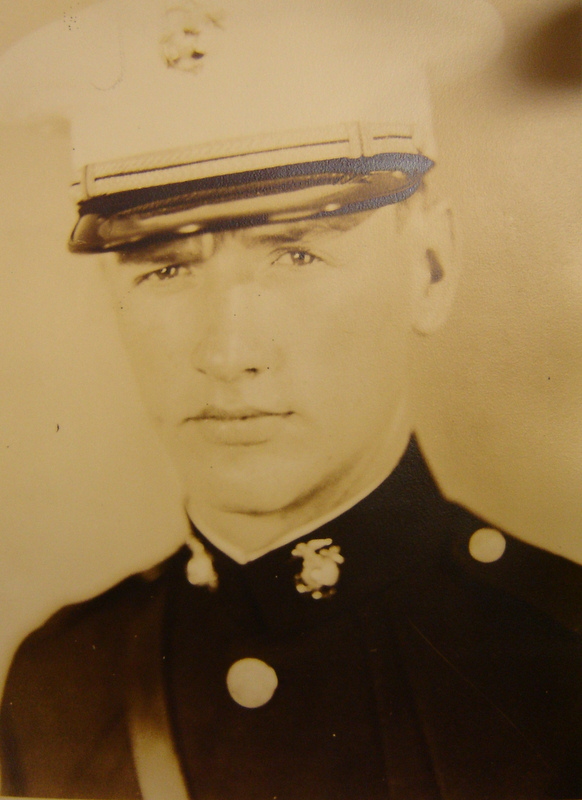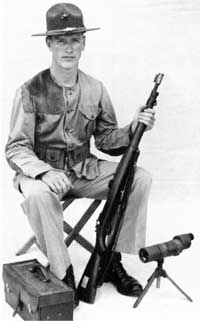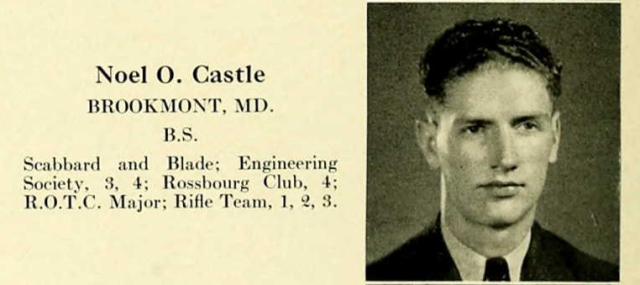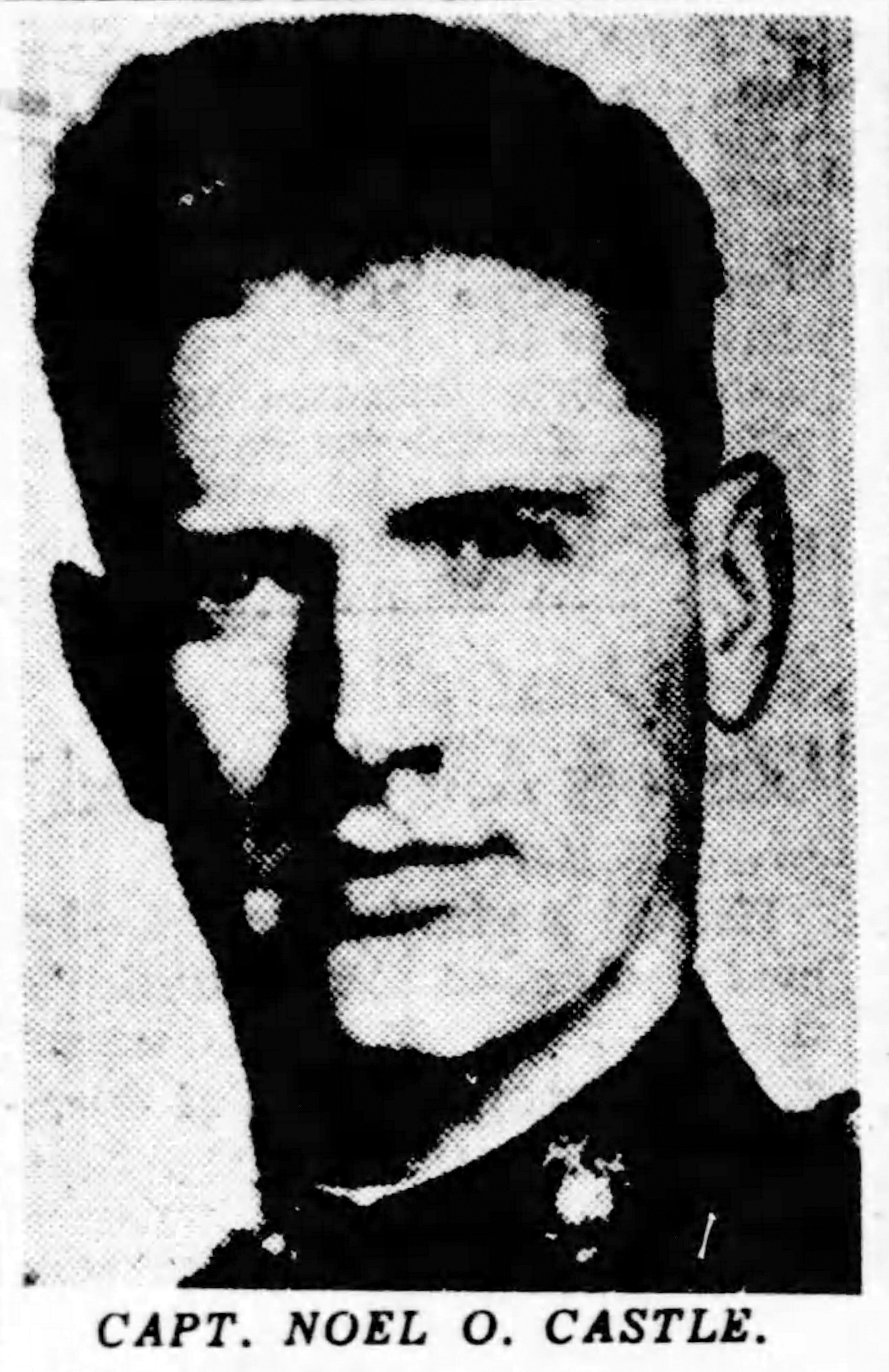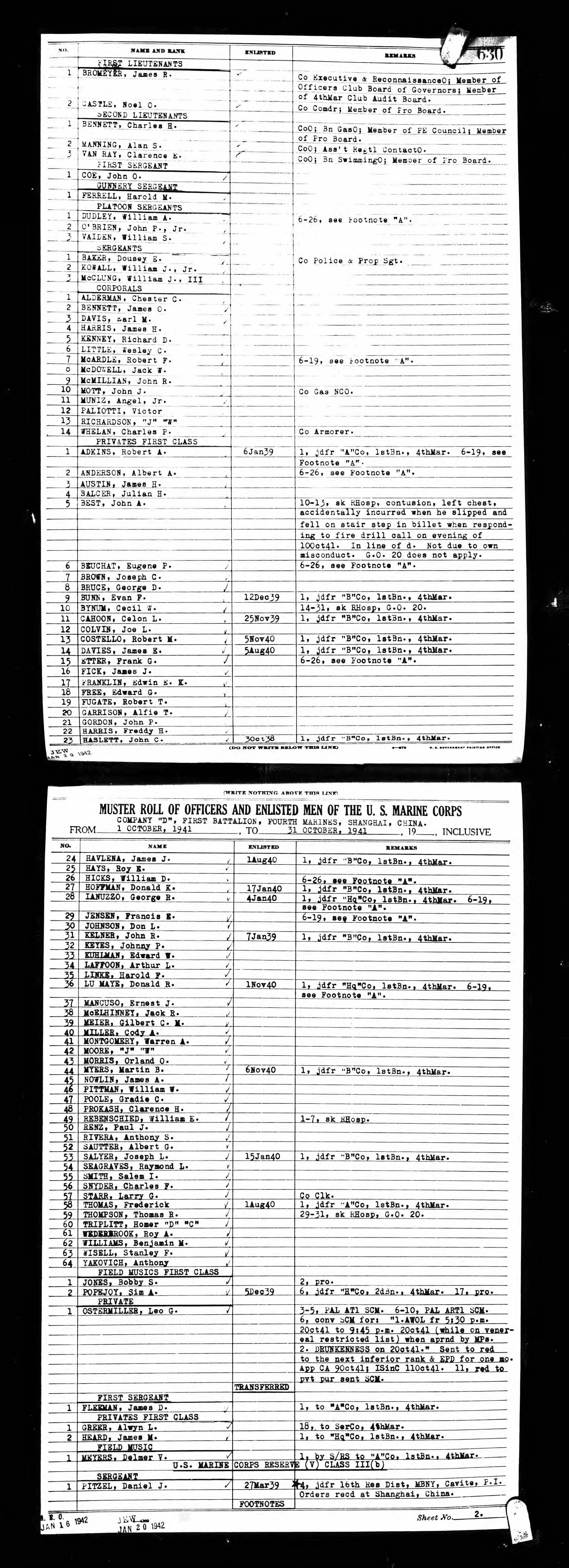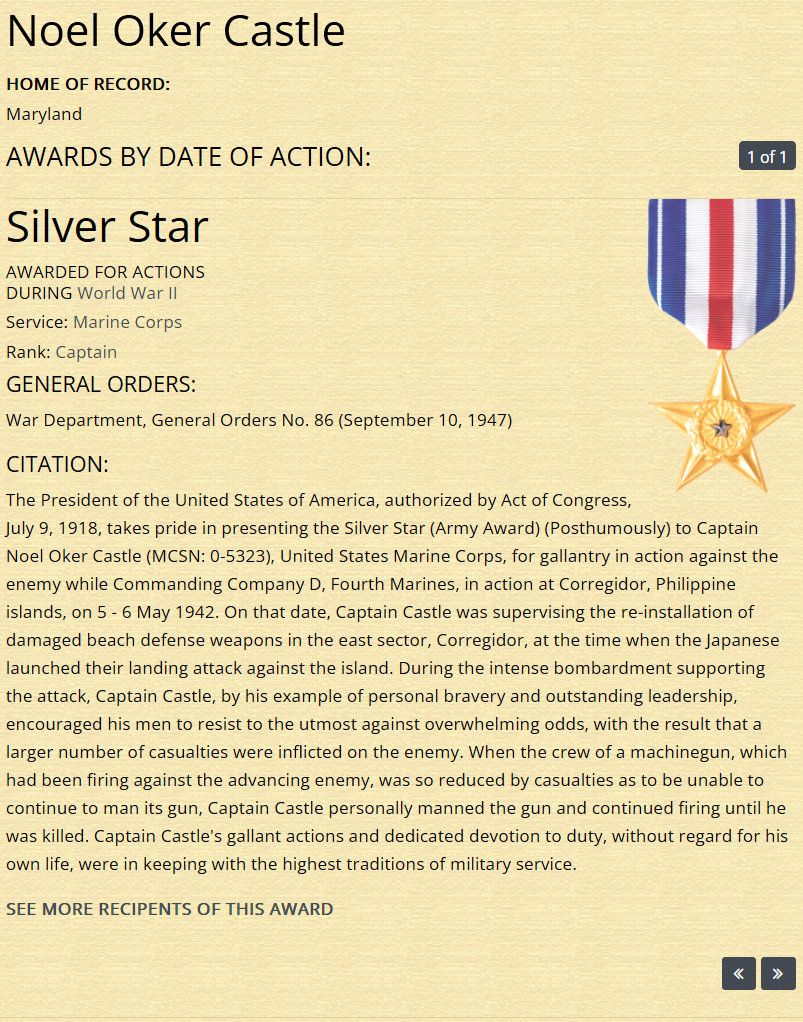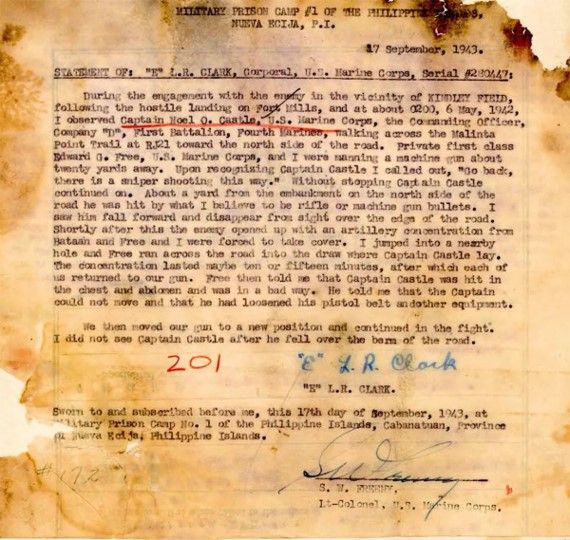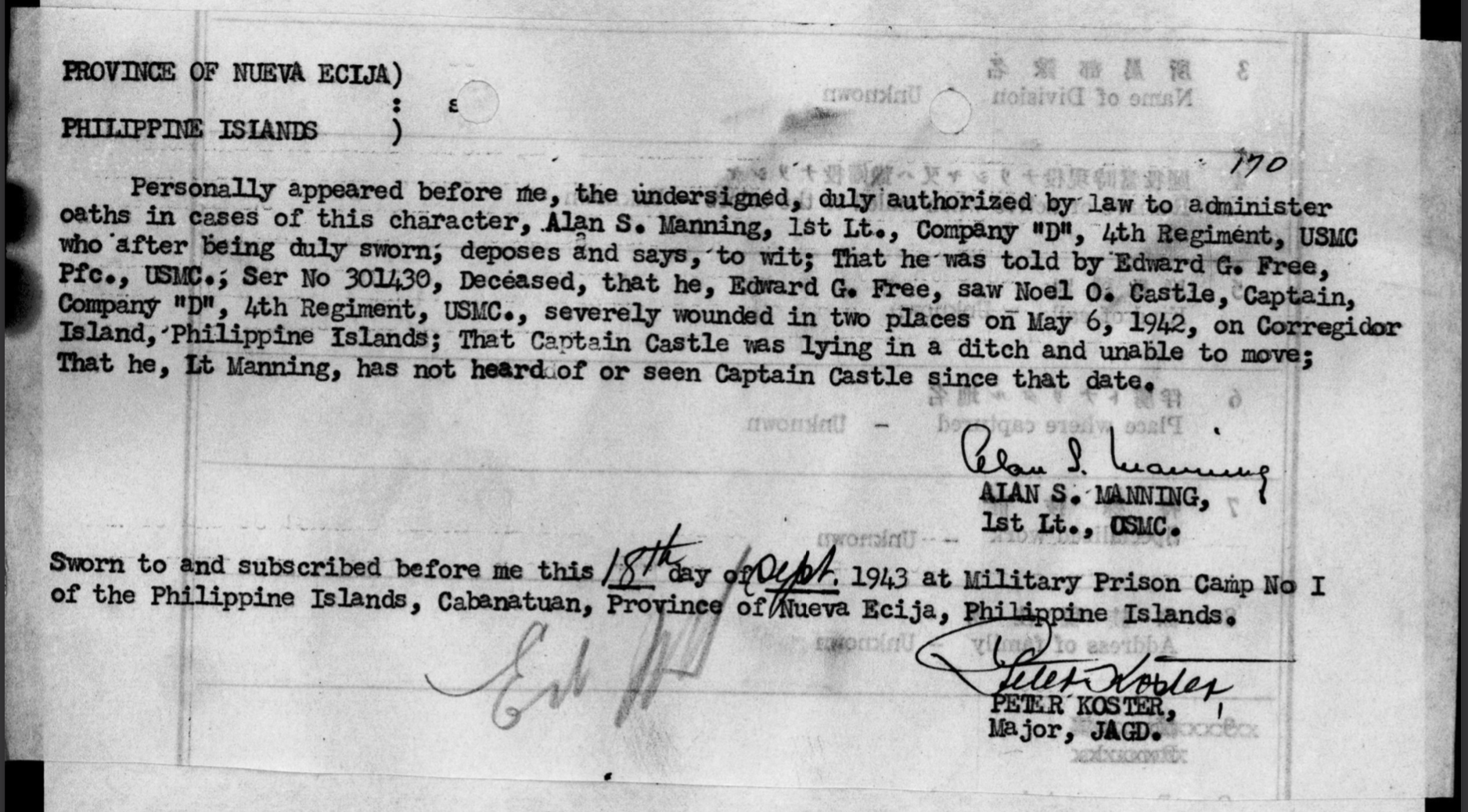The 1920 US Census shows the family as living in Washington, D.C. with the following family members living in the home:
HEAD Charles E Castle M 39y District of Columbia
WIFE Annie Castle F 38y District of Columbia
DAU Thelma Castle F 16y District of Columbia
SON Earl Castle M 14y District of Columbia
SON Alfred Castle M 11y District of Columbia
SON Noel Castle M 8y District of Columbia
The Castle family were Episcopalian. Castle was raised mainly in the Washington, D.C. and graduated from Central High School in early June, 1931, while living at 5303 8th Street, NW, Washington, D.C. He matriculated to the University of Maryland at College Park on 6/20/1932. Castle held the ROTC rank of Major and was a member of the rifle team when he received his Bachelor of Science degree from the School of Engineering (Electrical Engineering) in June 1936. At graduation he also received a Military Department Medal for contributing the most to the success of his ROTC battalion. Additionally, he was further commissioned a Second Lieutenant in the Army Reserve Officer Corps. In July 1936, Castle joined the Marines and due to his superior performance in ROTC, was immediately offered a commission as a Second Lieutenant of Marines. He traveled to the Philadelphia Navy Yard to attend Basic School, where he received instruction in the duties of a Marine infantry officer. Lieutenant Castle's skill with a rifle, which he had honed during his college years, was immediately noticed by his superiors. They sent him to Quantico in April 1937 and Castle spent several weeks with the rifle range detachment, where the instructors were so impressed with his prowess that they recommended him for the Marine Corps Rifle and Pistol marksmanship team. The team was based out of Wakefield, Massachusetts, and traveled to competitions at Camp Perry, Ohio.
Castle received his first command assignment in September, 1937, when he joined Company D, First Battalion, Fifth Marines in Quantico as a platoon leader. He served with them for the next nine months, both in Virginia and in Puerto Rico, before returning to the marksmanship team. Although a strong competitor, Castle did not take home the top award at the end of the season and upon return to regular duty he was assigned to the Ordinance Field Service School at Raritan Arsenal, New Jersey. From there, he joined the Fifteenth Marines (artillery) at Quantico, and served as the commander of a platoon with Battery B.
In 1939, Castle returned to the marksmanship team for his third season – and, as the adage goes, the third time was the charm. He was rewarded with the Distinguished Rifleman Badge – the highest marksmanship decoration in the nation – and a promotion to First Lieutenant. Not content to rest on those considerable laurels, Castle began preparing for his next challenge – pistol marksmanship. He returned to Quantico and joined the First Engineer Company as a platoon leader in October but in May 1940 Castle joined the Fourth Marines in Shanghai. Castle would join Company D in June, and by December was the company executive officer. He also received his second marksmanship distinction, having shot Gold in pistol competition.
Lieutenant Castle was something of a swashbuckling figure in the General George S. Patton, USA, mold. Castle augmented his two marksmanship badges with a pair of pearl-handled .45 pistols he wore whenever under arms.
In 1941, Castle was promoted to captain and took command of Company D. In November, the 4th Marines left China due to the heavy influence of Japanese forces and the 4th Marines were transported to the Philippines where they participated in the defense of the islands on Bataan and on Corregidor.
Castle's company manned heavy machine guns in the beach defenses of Corregidor, and spent weeks enduring Japanese shelling and bombing. He lost his first men, Truman Fain and Vernon Putnam on April 24, 1942, when their machine gun emplacement was hit. With limited resources at his disposal, Castle was forced to recover and repair as much equipment as he could. On May 5, Captain Castle was down on the beach supervising the re-installation of defenses when the Japanese opened up with their heaviest bombardment to date. Realizing that something was different, Castle encouraged his men to stand firm and, as the first Japanese boats came into view that night, sent the order to open fire with their heavy machine guns and 37mm artillery pieces as the Japanese were starting to land their landing forces.
According to "FROM SHANGHAI TO CORREGIDOR: Marines in the Defense of the Philippines" by J. Michael Miller, this is an account of the last few hours of Captain Castle's life:
"Marine Gunner Harold M. Ferrell went to 1st Battalion headquarters to alert Captain Noel O. Castle, commanding Company D, to the Japanese landing. He had sent a runner to Denver Battery where he found Japanese in the gun pits. Castle, a distinguished marksman and pistol shot who carried two pearl-handled .45-caliber pistols, assembled the Marines of Headquarters Company and the few Marines available of Company D to drive the Japanese off of Denver Hill. Castle dispatched Sergeant Matthew Monk with 15 drivers and cooks to occupy an abandoned beach defense position and secure his left flank. 'Do the best you can', he ordered Monk, 'Keep the Japanese out of the tunnel (Malinta Tunnel)'. Castle also scouted the reserve stations at critical road junctions, and cautioned the men, 'Maintain positions'. He then gathered his men for the counter-attack to Denver Battery, declaring, 'Let's go up there and run the bastards off'. (Gunner) Ferrell warned Castle from leading the attack himself, but the captain replied, 'I'm going to take these people up there and shoot those people's eyes out' and led his men to the hill. Castle met the Marines falling back from the Japanese advance, and joined in the battle. At 0140, the Japanese attacked the water tower and ran directly into the reinforced platoon led by Castle. The two forces collided in furious combat, practically 'face to face', remembered Corporal Joseph J. Kopacz. The Japanese advance was halted but the Marine attack was bloodily repulsed. Castle left the battle line and ran to an abandoned .30-caliber machine gun, which he put into working order, while 'completely covered by enemy fire'. Castle opened a devastating fire with the machine gun, forcing the Japanese to cover, which allowed the American advance to continue. The Japanese fell back from the water tanks to the Denver Battery positions, but Castle was hit by Japanese machine gun fire and killed. With their commander down, the attack ground to a halt."
Another version of Castle's death by an unknown Marine who was there, states that Captain Castle was moving down a trail and was killed by sniper fire or by a machine-gun and tumbled off the trail into the brush. He was observed to be badly wounded and dying. Before any assistance could be obtained for him, Japanese fire drove the Marines from the area. As a result, Captain Castle's body was lost.
For his actions on May 5 and 6 1942, Captain Castle was awarded the Silver Star. His citation reads as follows:
"The President of the United States of America, authorized by Act of Congress, July 9, 1918, takes pride in presenting the Silver Star (Army Award) (Posthumously) to Captain Noel Oker Castle (MCSN: 0-5323), United States Marine Corps, for gallantry in action against the enemy while Commanding Company D, Fourth Marines, in action at Corregidor, Philippine islands, on 5 – 6 May 1942. On that date, Captain Castle was supervising the re-installation of damaged beach defense weapons in the east sector, Corregidor, at the time when the Japanese launched their landing attack against the island. During the intense bombardment supporting the attack, Captain Castle, by his example of personal bravery and outstanding leadership, encouraged his men to resist to the utmost against overwhelming odds, with the result that a larger number of casualties were inflicted on the enemy. When the crew of a machine-gun, which had been firing against the advancing enemy, was so reduced by casualties as to be unable to continue to man its gun, Captain Castle personally manned the gun and continued firing until he was killed. Captain Castle's gallant actions and dedicated devotion to duty, without regard for his own life, were in keeping with the highest traditions of military service."
As of the writing of this memorial, Captain Castle's body has not been recovered. He is believed to have been buried in a small cemetery in an unmarked grave at Corregidor. It's location known only to God.
Captain Noel Oker Castle, Sn# O-005323, earned the following badges/decorations for his service during World War II (not in order of precedence):
- Silver Star Medal
- Purple Heart Medal
- Combat Action Ribbon
- American Defense Service Medal
- China Service Medal
- Asiatic-Pacific Theater of Operations Medal with 1 Bronze battle/campaign star
- World War II Victory Medal
- Presidential Unit Citation Ribbon(Army version)with Oak Leaf Device (2nd Award)
- Gold Distinguished Marksmanship Badge - Rifle
- Gold Distinguished Marksmanship Badge - Pistol
- Philippine Defense Medal with bronze campaign star
- Philippine Presidential Unit Citation Ribbon
Castle's last known address in the United States was 4104 Maryland Drive, Brookmont, Maryland.
**NOTE** - A small portion of this bio is based on information from the website missingmarines.com. They have done a fantastic job of researching approximately 3000 US Marines whose bodies were lost in the war. This writer wholeheartedly recommends their site for researchers or families of the missing. - Rick Lawrence, MSgt., USMC/USAFR {RET})
The 1920 US Census shows the family as living in Washington, D.C. with the following family members living in the home:
HEAD Charles E Castle M 39y District of Columbia
WIFE Annie Castle F 38y District of Columbia
DAU Thelma Castle F 16y District of Columbia
SON Earl Castle M 14y District of Columbia
SON Alfred Castle M 11y District of Columbia
SON Noel Castle M 8y District of Columbia
The Castle family were Episcopalian. Castle was raised mainly in the Washington, D.C. and graduated from Central High School in early June, 1931, while living at 5303 8th Street, NW, Washington, D.C. He matriculated to the University of Maryland at College Park on 6/20/1932. Castle held the ROTC rank of Major and was a member of the rifle team when he received his Bachelor of Science degree from the School of Engineering (Electrical Engineering) in June 1936. At graduation he also received a Military Department Medal for contributing the most to the success of his ROTC battalion. Additionally, he was further commissioned a Second Lieutenant in the Army Reserve Officer Corps. In July 1936, Castle joined the Marines and due to his superior performance in ROTC, was immediately offered a commission as a Second Lieutenant of Marines. He traveled to the Philadelphia Navy Yard to attend Basic School, where he received instruction in the duties of a Marine infantry officer. Lieutenant Castle's skill with a rifle, which he had honed during his college years, was immediately noticed by his superiors. They sent him to Quantico in April 1937 and Castle spent several weeks with the rifle range detachment, where the instructors were so impressed with his prowess that they recommended him for the Marine Corps Rifle and Pistol marksmanship team. The team was based out of Wakefield, Massachusetts, and traveled to competitions at Camp Perry, Ohio.
Castle received his first command assignment in September, 1937, when he joined Company D, First Battalion, Fifth Marines in Quantico as a platoon leader. He served with them for the next nine months, both in Virginia and in Puerto Rico, before returning to the marksmanship team. Although a strong competitor, Castle did not take home the top award at the end of the season and upon return to regular duty he was assigned to the Ordinance Field Service School at Raritan Arsenal, New Jersey. From there, he joined the Fifteenth Marines (artillery) at Quantico, and served as the commander of a platoon with Battery B.
In 1939, Castle returned to the marksmanship team for his third season – and, as the adage goes, the third time was the charm. He was rewarded with the Distinguished Rifleman Badge – the highest marksmanship decoration in the nation – and a promotion to First Lieutenant. Not content to rest on those considerable laurels, Castle began preparing for his next challenge – pistol marksmanship. He returned to Quantico and joined the First Engineer Company as a platoon leader in October but in May 1940 Castle joined the Fourth Marines in Shanghai. Castle would join Company D in June, and by December was the company executive officer. He also received his second marksmanship distinction, having shot Gold in pistol competition.
Lieutenant Castle was something of a swashbuckling figure in the General George S. Patton, USA, mold. Castle augmented his two marksmanship badges with a pair of pearl-handled .45 pistols he wore whenever under arms.
In 1941, Castle was promoted to captain and took command of Company D. In November, the 4th Marines left China due to the heavy influence of Japanese forces and the 4th Marines were transported to the Philippines where they participated in the defense of the islands on Bataan and on Corregidor.
Castle's company manned heavy machine guns in the beach defenses of Corregidor, and spent weeks enduring Japanese shelling and bombing. He lost his first men, Truman Fain and Vernon Putnam on April 24, 1942, when their machine gun emplacement was hit. With limited resources at his disposal, Castle was forced to recover and repair as much equipment as he could. On May 5, Captain Castle was down on the beach supervising the re-installation of defenses when the Japanese opened up with their heaviest bombardment to date. Realizing that something was different, Castle encouraged his men to stand firm and, as the first Japanese boats came into view that night, sent the order to open fire with their heavy machine guns and 37mm artillery pieces as the Japanese were starting to land their landing forces.
According to "FROM SHANGHAI TO CORREGIDOR: Marines in the Defense of the Philippines" by J. Michael Miller, this is an account of the last few hours of Captain Castle's life:
"Marine Gunner Harold M. Ferrell went to 1st Battalion headquarters to alert Captain Noel O. Castle, commanding Company D, to the Japanese landing. He had sent a runner to Denver Battery where he found Japanese in the gun pits. Castle, a distinguished marksman and pistol shot who carried two pearl-handled .45-caliber pistols, assembled the Marines of Headquarters Company and the few Marines available of Company D to drive the Japanese off of Denver Hill. Castle dispatched Sergeant Matthew Monk with 15 drivers and cooks to occupy an abandoned beach defense position and secure his left flank. 'Do the best you can', he ordered Monk, 'Keep the Japanese out of the tunnel (Malinta Tunnel)'. Castle also scouted the reserve stations at critical road junctions, and cautioned the men, 'Maintain positions'. He then gathered his men for the counter-attack to Denver Battery, declaring, 'Let's go up there and run the bastards off'. (Gunner) Ferrell warned Castle from leading the attack himself, but the captain replied, 'I'm going to take these people up there and shoot those people's eyes out' and led his men to the hill. Castle met the Marines falling back from the Japanese advance, and joined in the battle. At 0140, the Japanese attacked the water tower and ran directly into the reinforced platoon led by Castle. The two forces collided in furious combat, practically 'face to face', remembered Corporal Joseph J. Kopacz. The Japanese advance was halted but the Marine attack was bloodily repulsed. Castle left the battle line and ran to an abandoned .30-caliber machine gun, which he put into working order, while 'completely covered by enemy fire'. Castle opened a devastating fire with the machine gun, forcing the Japanese to cover, which allowed the American advance to continue. The Japanese fell back from the water tanks to the Denver Battery positions, but Castle was hit by Japanese machine gun fire and killed. With their commander down, the attack ground to a halt."
Another version of Castle's death by an unknown Marine who was there, states that Captain Castle was moving down a trail and was killed by sniper fire or by a machine-gun and tumbled off the trail into the brush. He was observed to be badly wounded and dying. Before any assistance could be obtained for him, Japanese fire drove the Marines from the area. As a result, Captain Castle's body was lost.
For his actions on May 5 and 6 1942, Captain Castle was awarded the Silver Star. His citation reads as follows:
"The President of the United States of America, authorized by Act of Congress, July 9, 1918, takes pride in presenting the Silver Star (Army Award) (Posthumously) to Captain Noel Oker Castle (MCSN: 0-5323), United States Marine Corps, for gallantry in action against the enemy while Commanding Company D, Fourth Marines, in action at Corregidor, Philippine islands, on 5 – 6 May 1942. On that date, Captain Castle was supervising the re-installation of damaged beach defense weapons in the east sector, Corregidor, at the time when the Japanese launched their landing attack against the island. During the intense bombardment supporting the attack, Captain Castle, by his example of personal bravery and outstanding leadership, encouraged his men to resist to the utmost against overwhelming odds, with the result that a larger number of casualties were inflicted on the enemy. When the crew of a machine-gun, which had been firing against the advancing enemy, was so reduced by casualties as to be unable to continue to man its gun, Captain Castle personally manned the gun and continued firing until he was killed. Captain Castle's gallant actions and dedicated devotion to duty, without regard for his own life, were in keeping with the highest traditions of military service."
As of the writing of this memorial, Captain Castle's body has not been recovered. He is believed to have been buried in a small cemetery in an unmarked grave at Corregidor. It's location known only to God.
Captain Noel Oker Castle, Sn# O-005323, earned the following badges/decorations for his service during World War II (not in order of precedence):
- Silver Star Medal
- Purple Heart Medal
- Combat Action Ribbon
- American Defense Service Medal
- China Service Medal
- Asiatic-Pacific Theater of Operations Medal with 1 Bronze battle/campaign star
- World War II Victory Medal
- Presidential Unit Citation Ribbon(Army version)with Oak Leaf Device (2nd Award)
- Gold Distinguished Marksmanship Badge - Rifle
- Gold Distinguished Marksmanship Badge - Pistol
- Philippine Defense Medal with bronze campaign star
- Philippine Presidential Unit Citation Ribbon
Castle's last known address in the United States was 4104 Maryland Drive, Brookmont, Maryland.
**NOTE** - A small portion of this bio is based on information from the website missingmarines.com. They have done a fantastic job of researching approximately 3000 US Marines whose bodies were lost in the war. This writer wholeheartedly recommends their site for researchers or families of the missing. - Rick Lawrence, MSgt., USMC/USAFR {RET})
Gravesite Details
Entered the service from Maryland.
Other Records
Sponsored by Ancestry
Advertisement
Advertisement




